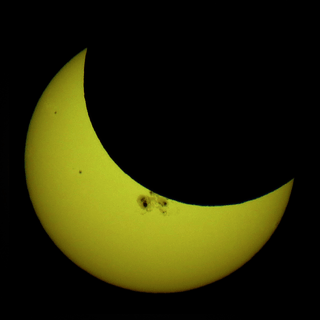Solar eclipse of January 4, 1992
An annular solar eclipse occurred on January 4–5, 1992. A solar eclipse occurs when the Moon passes between Earth and the Sun, thereby totally or partly obscuring the image of the Sun for a viewer on Earth. An annular solar eclipse occurs when the Moon's apparent diameter is smaller than the Sun's, blocking most of the Sun's light and causing the Sun to look like an annulus (ring). An annular eclipse appears as a partial eclipse over a region of the Earth thousands of kilometres wide. Annularity was visible in the Federal States of Micronesia, Nauru, Kiribati, Baker Island, Palmyra Atoll, Kingman Reef, and southwestern California, including the southwestern part of Los Angeles.
| Solar eclipse of January 4, 1992 | |
|---|---|
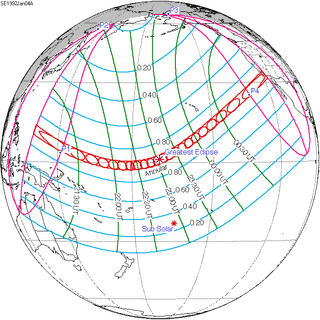 Map | |
| Type of eclipse | |
| Nature | Annular |
| Gamma | 0.4091 |
| Magnitude | 0.9179 |
| Maximum eclipse | |
| Duration | 701 sec (11 m 41 s) |
| Coordinates | 1°N 169.7°W |
| Max. width of band | 340 km (210 mi) |
| Times (UTC) | |
| Greatest eclipse | 23:05:37 |
| References | |
| Saros | 141 (22 of 70) |
| Catalog # (SE5000) | 9490 |
The duration of annularity at maximum eclipse (closest to but slightly shorter than the longest duration) was 11 minutes, 40.9 seconds in the Pacific. It will have been the longest annular solar eclipse until January 2, 3062, but the solar eclipse of December 24, 1973 lasted longer.[1]
Images

Related eclipses
Eclipses of 1992
Solar eclipses of 1990–1992
This eclipse is a member of a semester series. An eclipse in a semester series of solar eclipses repeats approximately every 177 days and 4 hours (a semester) at alternating nodes of the Moon's orbit.[2] This semester series contains only 7 eclipses.
| Solar eclipse series sets from 1990–1992 | ||||||
|---|---|---|---|---|---|---|
| Ascending node | Descending node | |||||
| Saros | Map | Gamma | Saros | Map | Gamma | |
| 111 | 1989 February 6 | -1.56550 | 116 | 1989 August 1 | 1.58396 | |
| 121 | 1990 January 26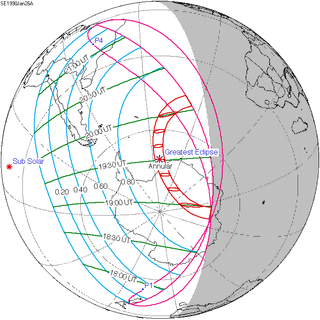 Annular | -0.94571 | 126 | 1990 July 22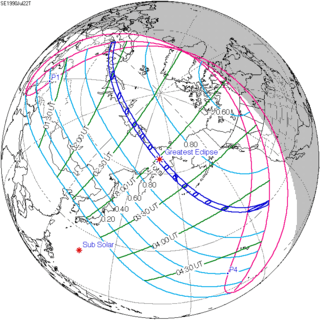 Total | 0.75972 | |
| 131 | 1991 January 15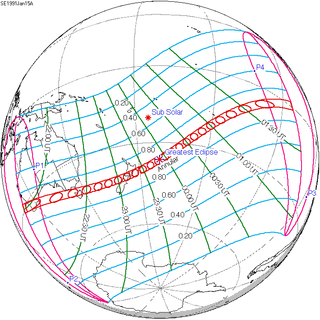 Annular | -0.27275 | 136 From Playas del Coco | 1991 July 11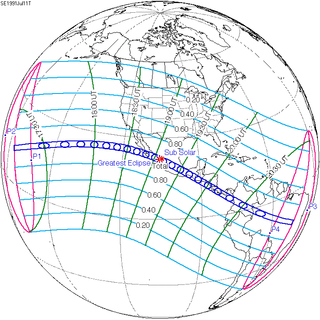 Total | -0.00412 | |
| 141 | 1992 January 4 Annular | 0.40908 | 146 | 1992 June 30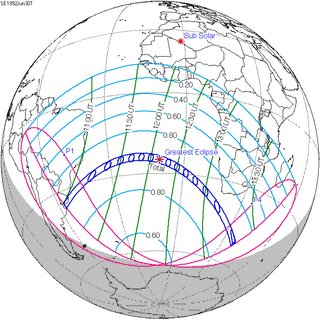 Total | -0.75120 | |
| 151 | 1992 December 24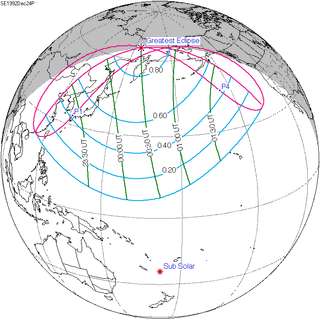 Partial | 1.07106 | 156 | 1993 June 20 | -1.56439 | |
Saros 141
Solar saros 141, repeating every about 18 years, 11 days, and 8 hours, contains 70 events. The series started with partial solar eclipse on May 19, 1613. It contains 41 annular eclipses from August 4, 1739, to October 14, 2460. There are no total eclipses in this series. The series ends at member 70 as a partial eclipse on June 13, 2857. The longest annular eclipse occurred on December 14, 1955, with maximum duration of annularity at 12 minutes and 9 seconds. All eclipses in this series occur at the Moon’s ascending node.[3]
| Series members 17–36 occur between 1901 and 2259 | ||
|---|---|---|
| 17 | 18 | 19 |
 November 11, 1901 |
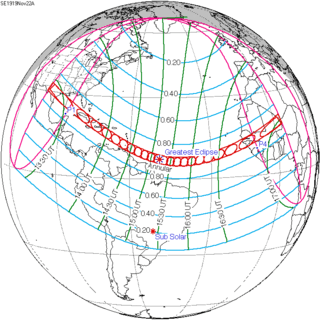 November 22, 1919 |
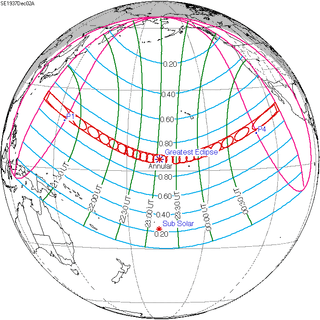 December 2, 1937 |
| 20 | 21 | 22 |
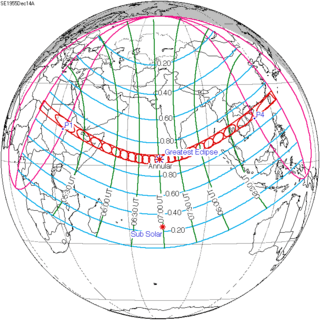 December 14, 1955 |
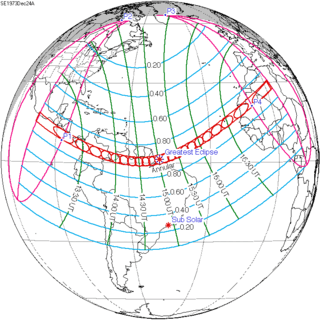 December 24, 1973 |
 January 4, 1992 |
| 23 | 24 | 25 |
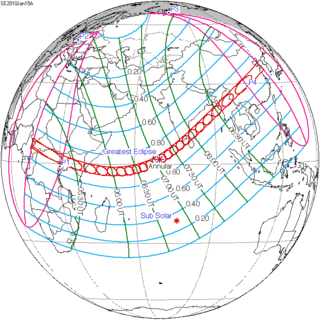 January 15, 2010 |
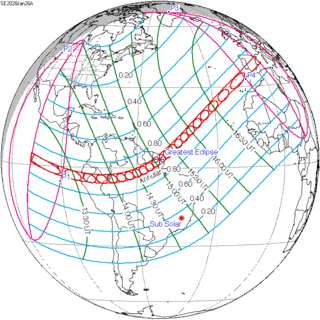 January 26, 2028 |
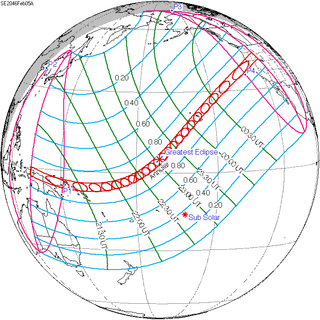 February 5, 2046 |
| 26 | 27 | 28 |
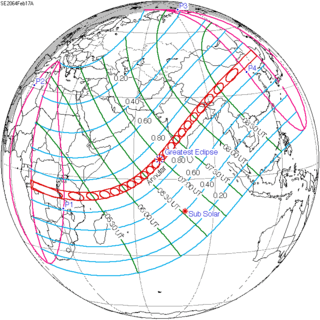 February 17, 2064 |
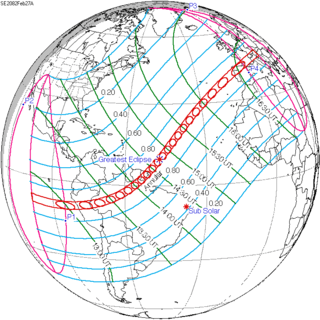 February 27, 2082 |
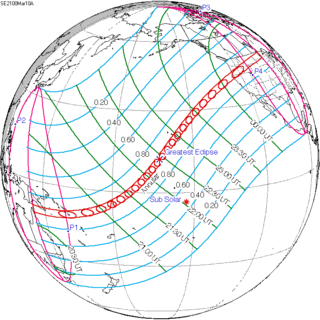 March 10, 2100 |
| 29 | 30 | 31 |
 March 22, 2118 |
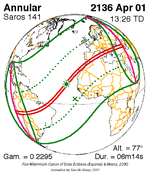 April 1, 2136 |
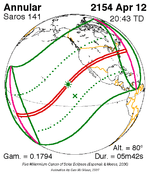 April 12, 2154 |
| 32 | 33 | 34 |
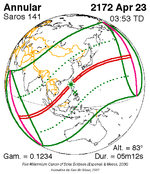 April 23, 2172 |
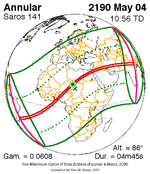 May 4, 2190 |
 May 15, 2208 |
| 35 | 36 | |
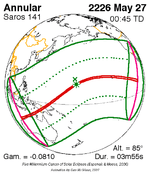 May 27, 2226 |
 June 6, 2244 | |
Tritos series
This eclipse is a part of a tritos cycle, repeating at alternating nodes every 135 synodic months (≈ 3986.63 days, or 11 years minus 1 month). Their appearance and longitude are irregular due to a lack of synchronization with the anomalistic month (period of perigee), but groupings of 3 tritos cycles (≈ 33 years minus 3 months) come close (≈ 434.044 anomalistic months), so eclipses are similar in these groupings.
| Series members between 1901 and 2100 | |||
|---|---|---|---|
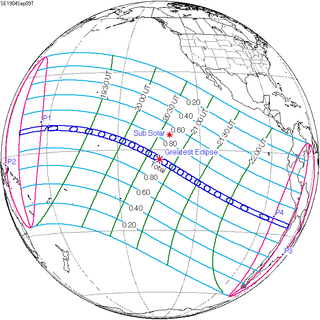 September 9, 1904 (Saros 133) |
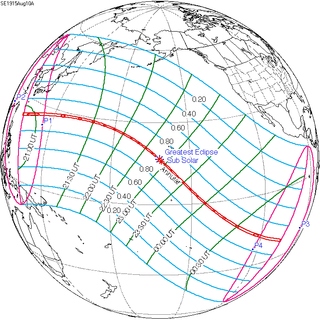 August 10, 1915 (Saros 134) |
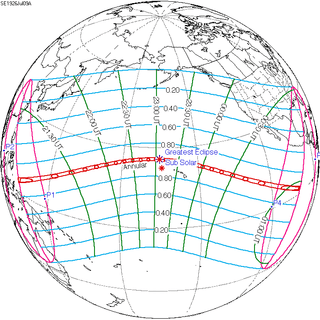 July 9, 1926 (Saros 135) | |
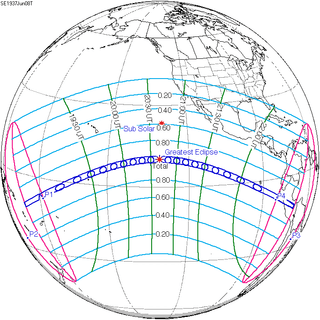 June 8, 1937 (Saros 136) |
 May 9, 1948 (Saros 137) |
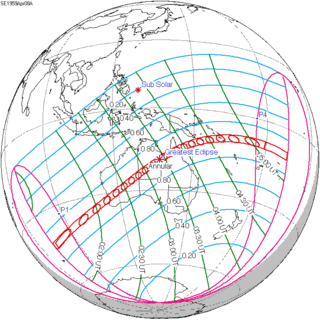 April 8, 1959 (Saros 138) | |
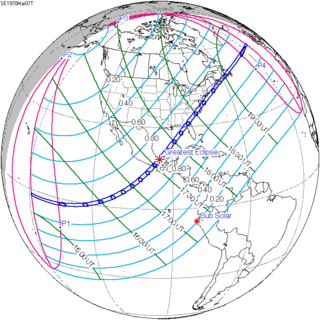 March 7, 1970 (Saros 139) |
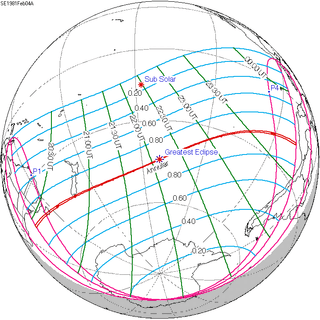 February 4, 1981 (Saros 140) |
 January 4, 1992 (Saros 141) | |
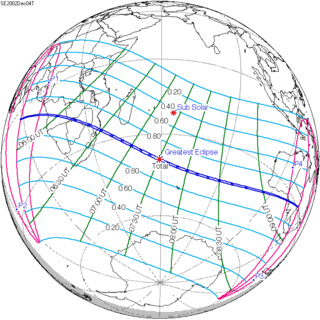 December 4, 2002 (Saros 142) |
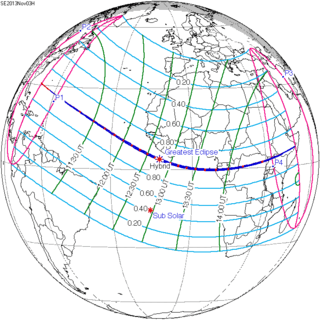 November 3, 2013 (Saros 143) |
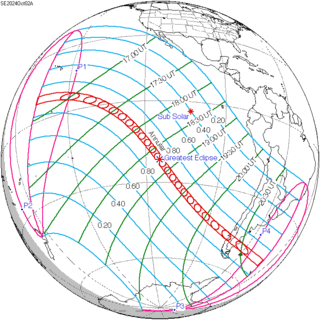 October 2, 2024 (Saros 144) | |
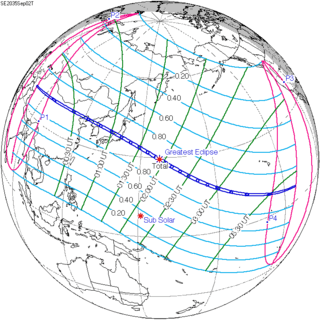 September 2, 2035 (Saros 145) |
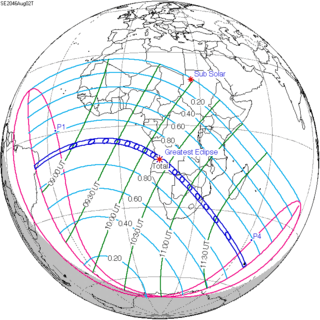 August 2, 2046 (Saros 146) |
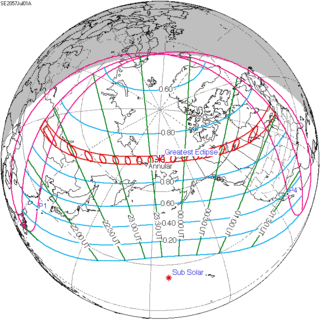 July 1, 2057 (Saros 147) | |
 May 31, 2068 (Saros 148) |
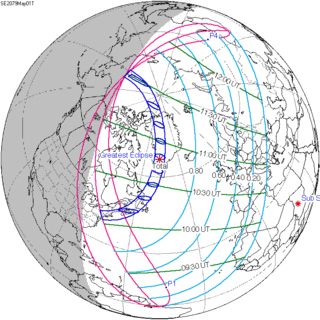 May 1, 2079 (Saros 149) |
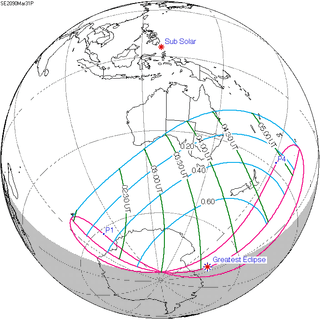 March 31, 2090 (Saros 150) | |
Metonic series
The metonic series repeats eclipses every 19 years (6939.69 days), lasting about 5 cycles. Eclipses occur in nearly the same calendar date. In addition, the octon subseries repeats 1/5 of that or every 3.8 years (1387.94 days). All eclipses in this table occur at the Moon's ascending node.
| 22 eclipse events between January 5, 1935 and August 11, 2018 | ||||
|---|---|---|---|---|
| January 4-5 | October 23-24 | August 10-12 | May 30-31 | March 18-19 |
| 111 | 113 | 115 | 117 | 119 |
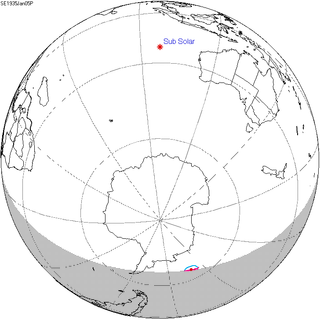 January 5, 1935 |
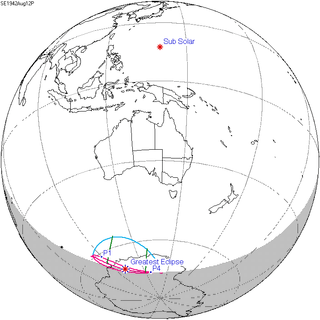 August 12, 1942 |
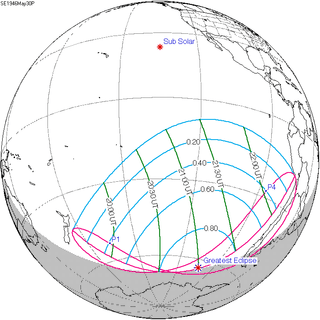 May 30, 1946 |
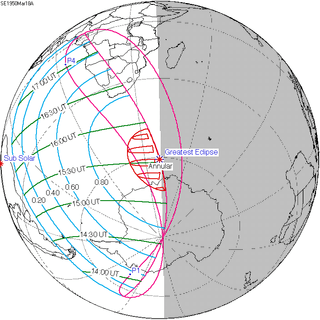 March 18, 1950 | |
| 121 | 123 | 125 | 127 | 129 |
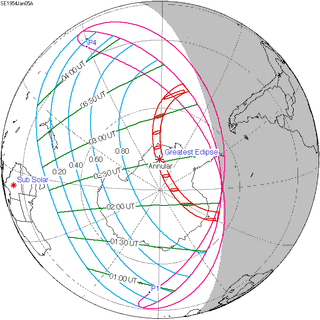 January 5, 1954 |
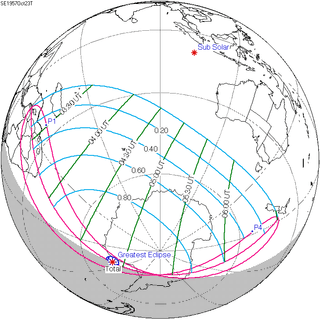 October 23, 1957 |
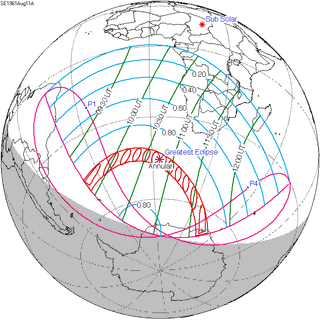 August 11, 1961 |
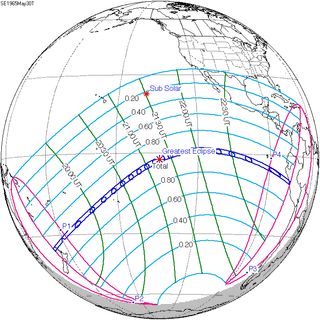 May 30, 1965 |
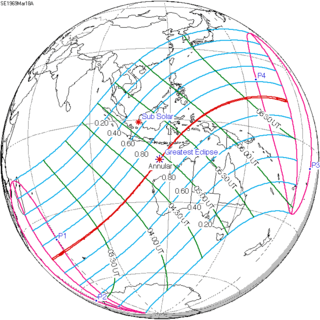 March 18, 1969 |
| 131 | 133 | 135 | 137 | 139 |
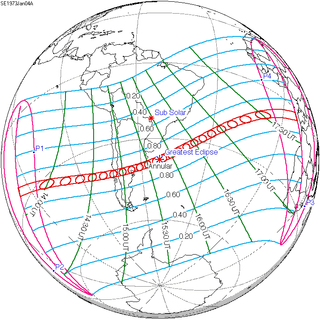 January 4, 1973 |
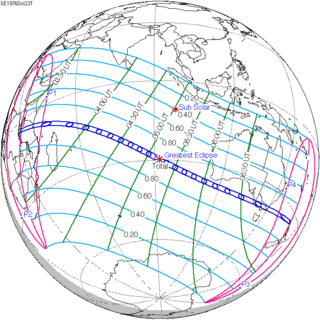 October 23, 1976 |
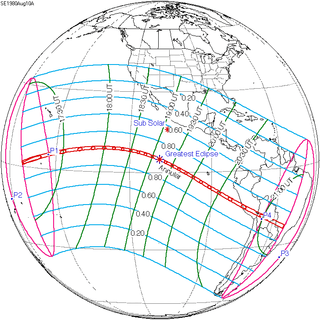 August 10, 1980 |
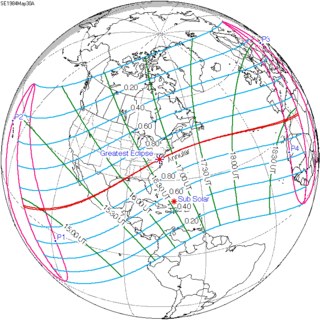 May 30, 1984 |
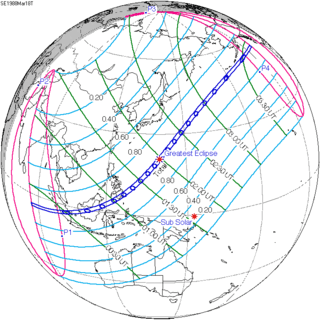 March 18, 1988 |
| 141 | 143 | 145 | 147 | 149 |
 January 4, 1992 |
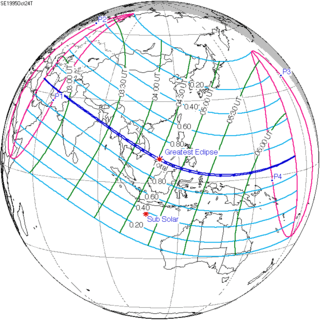 October 24, 1995 |
 August 11, 1999 |
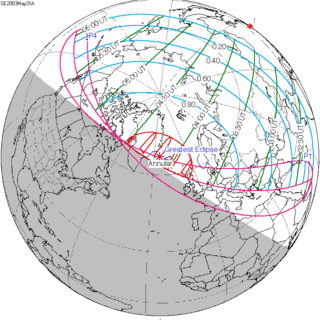 May 31, 2003 |
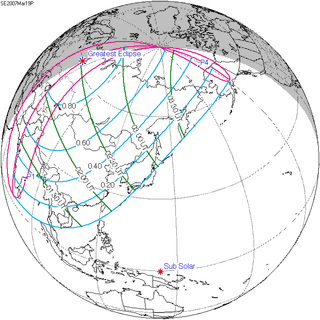 March 19, 2007 |
| 151 | 153 | 155 | 157 | 159 |
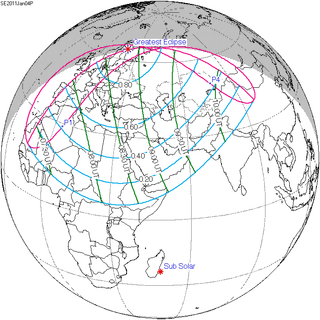 January 4, 2011 |
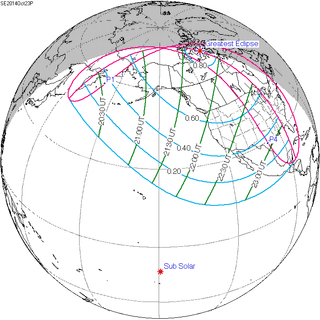 October 23, 2014 |
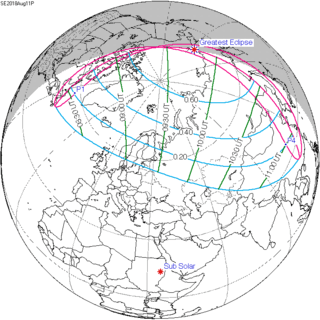 August 11, 2018 |
||
Notes
- "Annular Solar Eclipses with Durations Exceeding 11m 00s: -3999 to 6000". NASA Eclipse Web Site.
- van Gent, R.H. "Solar- and Lunar-Eclipse Predictions from Antiquity to the Present". A Catalogue of Eclipse Cycles. Utrecht University. Retrieved 6 October 2018.
- Saros Series Catalog of Solar Eclipses NASA Eclipse Web Site.
References
- Earth visibility chart and eclipse statistics Eclipse Predictions by Fred Espenak, NASA/GSFC
Photos:
- APOD Ring of Fire Revisited, annular eclipse at sunset
.jpg)
